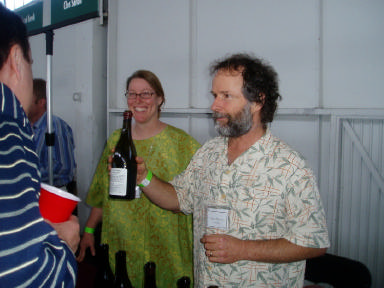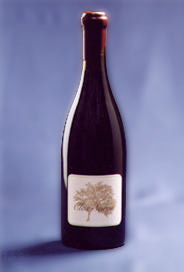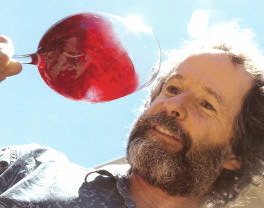Clos Saron: Artisan Wines
The Sierra Foothills is not a region that comes to mind when you think about sources of California Pinot
Noir. However, this appellation has a history with Pinot Noir dating back to the 1880s. According to
John Winthrop Haeger (North American Pinot Noir), Eugene Hilgard of the University of California
directed the planting of experimental vineyards in the foothills of the Sierra Nevada near the town of
Jackson in Amador County. More than 150 varietals including Pinot Noir were planted. The Jackson
station was closed in 1903 as the experiment proved untenable. Some surviving Pinot Noir vines were
discovered in 1963 and the so-called Jackson clones remained of interest , presumably because they
exhibited some resistance to cold, having become adapted to frigid winters in the Sierra Nevada. University
of California Davis classified them as UCD 1, UCD 9, UCD 16 and UCD 29. The Jackson clones
were never widely planted. According to Haeger, “The Jackson clones have the distinction of being
the earliest documented imports of Pinot Noir still under cultivation in North America, having unarguably
been imported before 1890 - and perhaps considerably earlier.”
The Sierra Foothills appellation is a sprawling AVA of 2.6 million acres that includes Amador, El Dorado,
Nevada, Placer, Calaveras, Tuolumne, Mariposa, and Yuba counties. The AVA is characterized
by hot days and very cool nights, the range depending on the elevation. There are now well over 100
wineries that call the Sierra Foothills home and the area has developed a deserved reputation for
hearty Zinfandel.

Gideon Bienstock and wife Saron Rice have developed a very small and young vineyard in the northern
limits of the Sierra Foothills AVA. Gideon has over 28 years of experience in the wine industry as
buyer, seller, educator, writer and winemaker (he is also the winemaker for the famed and nearby
Renaissance Vineyard & Winery) and Saron has considerable knowledge of viticulture. Together, they
have set a goal to transcend all of the preconceived notions that exist about what winegrowing possibilities
exist in this region. What they have started, and what they have accomplished to date, is highly
unusual from just about every point of view. They only work with organic fruit and farm all of their
grapes, including sourced grapes, themselves. They specialize in Pinot Noir and non-traditional
blends of other red and white varietals. Winemaking is pure and simple - no acid corrections, no fining
or filtration, no inoculations, no racking and very minimal sulfur dioxide additions during barrel
aging. The barrels are sourced from the Rousseau family in Gevrey-Chambertain, the wine is aged on
its lees for as long as necessary, often until the day of bottling. The wine is then bottled manually, direct
from barrel. Each bottle is numbered. Not surprisingly, the result is highly unique wines available
in very limited quantities and consistently high in quality. One-of-a-kind to be sure.
The Home Pinot Noir Vineyard and tiny winery are located in a cool microclimate in the Oregon House
Valley just west of the Sierra Nevada mountain range. 4,500 vines are planted on a gentle, well-drained,
north-east facing slope. The soil is clay loam on top of volcanic ash, decomposed granite and quartz. According to Gideon, the soil “is a mish-mash of alluvial layers and fractured volcanic rocks.”
The microclimate is cool by Sierra Foothills standards. Harvest dates are typically from early September
to early October. The vineyard is surrounded and protected by hills on three sides. Until around
1980, when the first half acre was planted, this area was all forested. The expansion to 2½ acres in
1999 required clearing of the rest of the area, which was still densely wooded. The climate is
continental, with typical summer daytime highs of 90°-95° and nightime lows of 55°-65°, with winter
highs of 45°-55° and lows of 25°-35°. The site is prone to spring frosts. The main pest pressure is from
birds and bird netting is used to protect the fruit.”

Farming of the vineyard is 100% organic although there is no organic certification. No herbicides,
pesticides, insecticides are used and very limited elemental sulfur is employed to control mildew.
There is limited mowing, leaving 25% of the surface untouched to preserve the natural habitat for
insects and a variety of plants which would vanish if the whole area was mowed. No soil amendments
and/or fertilizers are used other than organic compost and compost tea, and occasionally some of the
biodynamic preparations. Rabbits and chickens are farmed on the property and their “production” is
used to supplement purchased compost. Plans are afoot to introduce a few mini-sheep next year to
assist in the mowing and composting programs. Irrigation is minimal, primarily to keep younger vines
alive. Cover crops are used to help balance topical imbalances in the soil and to enrich the top soil,
which is poor and humus.
Originally the site was planted with Cabernet Sauvignon and Merlot but these varieties rarely ripened
here properly because of the cool microclimate. In 1995, the vines were grafted to Pinot Noir. In 1999,
an additional 1.75 acres of mixed clones (113, 115, 667, 777, Wente, Swan, Pommard, and a few
reportedly imported from Burgundy) were planted. Crop levels are extremely low with older vines
yielding around 1 ton per acre and the younger vines less than half that much.
Gideon notes that harvest is done over 3-4 weeks, with repeated passes through the vines, picking
only perfectly ripe fruit (perfectly ripe is determined by the grapes’ color, stem and seed maturation
and a very slight softness to the touch of the grapes). The grapes are destemmed and fermentation
follows in open-top fermenters lasting anywhere from 4 to 14 days. The wine is pressed at dryness
very gently, directly into barrels, about 50-100% new. Aging is typically 13-16 months, at which time
the wine is racked off the lees by compressed nitrogen into a blending container and bottled manually
by gravity.
The result is a Clos Saron Home Vineyard Pinot Noir and Clos Saron Pinot Too (from young Home Vineyard vines and sourced fruit) that are very uniquely expressive of this region. The wines in no
way duplicate that of any other California Pinot Noir. They are not especially suited for comparative
tastings, but best enjoyed at the dinner table, where they interact with food. Their tannins are easily
neutralized and harmonized by the proper table companions. Gideon says, “I like to think that they
offer a respectable alternative for those whose palates get overwhelmed and tired of the superalcoholic,
super-rich, and super-thick. The wines are for those who keep tasting and following what is
happening in their glass past the first couple of sips and throughout dinner.”
Personally, I find Clos Saron Pinot Noirs highly distinctive and among the most, dare I say,
“Burgundian,” Pinot Noirs in California with an emphasis not on flashy fruit, but on gamy, earthy,
mushroom, mineral and barnyard highlights, along with a healthy tannic structure that bodes well for
aging. It takes a real Pinot Noir connoisseur to appreciate these wines.

Gideon describes his Home Vineyard Pinot Noir as follows.
“Tends to be structured, spicy, minerally and earthy, with strong
vintage variation in terms of balance and expression. It tends to
age slowly and improve over time in terms of texture, refinement,
harmony and added flavor complexity. In my view, only the 2000
vintage is sort-of fully mature. With the exception of that vintage,
earlier vintages were more structured than more recent ones. To
this point, none of the aging wines have developed symptoms of
over-the-hillness, and to my mind, this indicates that this terroir
produces long-lived Pinot Noirs by California standards, reaching
maturity at 8-12(?) years in the bottle.”
With regards to his Pinot Too Pinot Noir he comments. “In 2002
and 2003, the young vines started producing very limited quantities
of grapes. I did not want to blend these with the older vine
fruit and chose to buy some grapes from the nearby Renaissance
vineyard. This blend was named “Pinot Too” and the older vine
Pinot Noir became the “Home Vineyard “ (the 1999-2001 vintages
were simply labeled Clos Saron Pinot Noir). The Pinot Too
proved to be fruitier and earlier maturing than the Home Vineyard
version of the same vintages. Beginning with the 2004 vintage, I found the quality and character of the
young vine fruit to be “worthy” of being blended with the older vine grapes to produce the Home
Vineyard Pinot Noir.”
2004 Clos Saron Home Vineyard Sierra Foothills Pinot Noir
13.3%, 47 cases, $45.
This year Gideon said was his experiment with joining the “ripeness is all” crowd. He waited longer for more physiological ripeness than ever before or since. Water had to be added to the must. “In retrospect, I think
it did not turn out too bad, but I feel that we went further in that direction than I would ever go again.
In my perception, the very hint of over-ripeness, which this wine does show to my palate, compromises
the typicity and terroir expression, which are the wine’s soul. That said, I have been told by
many that this is their favorite vintage of ours.”
·
I have to admit, I liked this wine very much too. The aromatics are terrific with plenty of barnyard, mushroom and minerality. The flavors are subtle and alluring with luscious strawberry and cherry fruit. Just the right mix of fruit and earthiness. No over-ripeness evident. The tannins are well-concealed and the whole package is nicely balanced. Makes you want to clap your hands.
2003 Clos Saron Pinot Too Sierra Foothills Pinot Noir
13.2% alc., 56 cases, $30.
·
This is a “tannic mutha’.” Heady spiced and confected cherries with a floral note that composes the attractive aromatics. The masculine Pinot extract is currently obscured by oak. This wine needs cheese or hearty food.
2003 Clos Saron Home Vineyard California Pinot Noir
13.3% alc., 31 cases, $45.
·
Moderate reddish-purple
color in the glass. The fruit plays second fiddle to the aromas and flavors of loamy earthy, smoke, tobacco and
ash. There is plenty of drying tannins and a bright acid spine. A rustic wine with plenty of heft and a prominent
smoky tone throughout. Decent.
2003 Clos Saron Home Vineyard Sierra Foothills Pinot Noir
13.3% alc., 32 cases, $45.
Ripening was more even in this vintage. There was Botrytis pressure for the first time. Once again, Gideon and
Saron were removing individual defective grapes from otherwise beautifully ripe clusters. The wine
seemed similar to the 1999 vintage when bottled showing a powerful presence. Unlike the 1999, there
was a distinctive chocolate aftertaste early on.
·
Very dark ruby in color. Barnyard and mushroom scents dominate. Woody tart cherry flavors with noteworthy drying tannins on the finish yet to be shed. Muscular but not harsh. Needs further time in the cellar.
2002 Clos Saron Pinot Too Sierra Foothills Pinot Noir
13.2% alc., 29 cases, $25.
Another frost damage year. In a larger vineyard, 2002 would have been a disastrous vintage, due to a combination of both unripe and over-ripe grapes in the same clusters. Hours were spent painstakingly removing
every under-ripe and over-ripe grape from every cluster in order to crush only perfectly even, ripe
fruit.
·
Rather restrained aromatics with deep, dark fruits, a hint of oak, cardamom, ripe tomato and char.
Redder fruits peak through in the finish, particularly candied cherry. Tannins are reigned in. A very easy
drink now and thoroughly enjoyable.
2001 Clos Saron Sierra Foothills Pinot Noir
13.0% alc., 28 cases, $45.
A very structured and concentrated vintage with yields reduced by extensive frost damage. A notable spice dimension at the finish has distinguished this vintage.
·
Aromas of crushed dark cherries, cassis, game, pepper, barnyard and a hint of oak spice lead off. Lovely black raspberry fruit lingers on an elegant frame. Burly tannins. Offers a clear and unmistakable sense of terroir. I later decanted the wine which softened the tannins. This wine will reward even further aging. If drunk now, try a ripe Epiosses cheese or hearty meats like duck and game.
1999 Clos Saron Sierra Foothills Pinot Noir
13.0% alc., 58 cases, $45. Inaugural vintage.
A “large” production not matched again until the 2005 vintage. Yields were 1.5 tons per acre. This was initially a
very dense, structured and concentrated wine that has aged gracefully and acquired more elegance
and harmony.
·
Complex bouquet of dark Pinot fruits including plums and wild berries, mushrooms, farmyard,
smoke, and even a touch of spearmint and flowers. A rustic wine that is structured and stuffed with
flavors of black cherry, mushroom and game. Still showing a fair amount of tannin.
2005 produced 51 cases in a more elegant, reserved style with the tannins more refined and better
integrated into the wine. Gideon notes, “To my taste, this is another big step in the right direction and
the wine will reward the patient ones.” I tasted the 2005 vintage at this year’s Pinot Days: “A strikingly
refined Pinot Noir with appealing cherry and berry flavors and lovely elegance.” 2006 was just bottled
and produced nearly 100 cases. At this stage, “it seems extremely well balanced, with polished tannins
and a soft texture, both rich and sensuous at the same time.” I tasted a 2006 barrel sample at Pinot
Days also and found it equally impressive compared to the 2005. 2007 produced about 100 cases
again, following another severe frost season. The style is close to the 2006, perhaps a tad lighter.
In 2005, Gideon began sourcing grapes from Texas Hill Road Vineyard which is in the same locale. I
tasted the 2005 and 2006 (barrel sample) at this year’s Pinot Days and my comments were as follows.
“The 2005 is more structured and tannic and quite apart from the Home Vineyard in style, but retains
its own rustic and earthy charm. The 2006 barrel sample was even better. Gideon began farming the
Texas Hill Road Vineyard in 2006 and it shows.”
The Clos Saron Pinot Noirs are a work in progress and it is a revelation to see an accomplished winemaker
dealing with the vagaries of each vintage and searching for the best way to express the terroir
of his vineyard. Gideon says, “Over these years, I see a progression towards more refinement and balance.
I believe that our current vintages will prove to be as long lived as the early ones, but have better
integration and class, while preserving the individuality and distinctive expression. I like to think
they offer a respectable alternative for those whose palates get overwhelmed and tired of the super alcoholic, super rich and super thick… .for those who keep tasting and following what is happening in
their glass past the first couple of sips and throughout dinner. Our wines are not ideally suited for
comparative tastings but for the dinner table, where they interact with food. Their tannins are easily
neutralized and harmonized by the proper dishes and table companions. I have enjoyed our Pinot
Noirs with Epoisses, Brie and Pond l’Eveque cheeses, with grilled salmon, sushi, duck, home grown
rabbits in endless variations, pheasant and wild turkey.”

Clos Saron is located at 9269 Collin House Rd, PO Box
1004, Oregon House, CA. 530-692-1080. The website is
www.clossaron.com. I have visited and tasted in the small
winery on the property with Gideon in the past. For those
looking for a unique setting and an adventurous trip, I
highly recommend a visit. Tiny quantities of older vintages
are held back for the benefit of those brave few who
take the trouble to visit ($65-$75 per bottle). Magnums of
the 1999 and 2000 Clos Saron Pinot Noir and 2003 Clos
Saron Pinot Too are still available. Gideon also crafts a
number of interesting special cuvees from leased vineyards
he and Saron farm at Renaissance (see below). Their
blocks are at altitudes of 1700-2400 feet on a wide range of
soil types and exposure combinations. The vines are over 25 years old. An example is Black Pearl
which is a blend of Merlot, Cabernet Sauvignon and Syrah.
Renaissance Vineyard & Winery Gideon Bienstock has been the winemaker here since 1994 and
he has been responsible for bringing refinement and elegance to Renaissance wines. Production has
been downsized and focus has turned to expressing the multitude of unique Renaissance terroirs.
Gideon notes, “You can taste the remarkable difference from various parts of our vineyard. Over
many years of experimentation, we have learned to match every grape variety to the right microclimate,
exposure, and soil combination and we maximize these differences by our organic viticulture
and by vinifying separate lots individually.” Noted wine writer Matt Kramer (New California Wine) has
called Renaissance “one of the most unusual and exciting wineries in California.” James Halliday
(Wine Atlas of California) claimed, “If there is a more remarkable vineyard in California, I did not see
it.” Renaissance was created by The Fellowship of Friends in the 1980s, and its founding winemaker
was Karl Werner, formerly of Schloss Vollrads in the Rheingau. There are currently 60 acres of vineyards
on steep, terraced slopes, all drip irrigated. Production is about 3,500 cases. The winery has had
most success with Cabernet Sauvignon and it is the flagship wine of the Renaissance label, but there
have been notable examples of Rhone varietals such as Viognier, Roussanne, Syrah, Grenache and
Mourvedre. I have never sampled the Pinot Noir from Renaissance and I have not visited, but I understand
the tranquility and charm of the estate is unmatched in California. There are antique fountains, a
famous rose garden, a French Potager kitchen garden and olive trees from which award-winning
Apollo Olive Oil is produced. Renaissance is a 75 minute drive from Sacramento, located on E21 off
Hwy 20 east of Marysville at12587 Rices Crossing Road, Oregon House, CA. 800-655-3277. The website
is www.rvw.com.